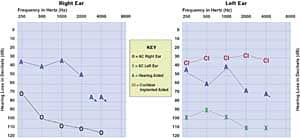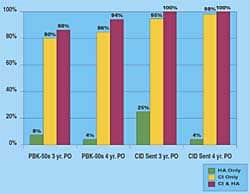Directional microphones remain the only proven way to improve the signal-to-noise ratio in noisy environments. However, recent studies show that directional systems are not necessarily preferred in all situations—which is why virtually all modern directional systems employ a means for switching between the omni and directional modes. Even though directional hearing aids are extremely valuable, not all patients want to manually switch between modes. An automatic directional system is ideal for these patients. This article provides information on directional systems, as well as how best to fit and verify automatic directional microphone hearing aids.
Every hearing care provider is challenged with providing the best hearing solution for their patients. As such, the search for a solution may become demanding with the myriad of amplification choices. A challenge may arise when a given client—we’ll call her Mrs. Jones—enters your office.
Mrs. Jones’ primary complaint is that she cannot hear in noisy situations, particularly when she goes to lunch with her friends, and her present hearing devices do not seem to help. When you explain to Mrs. Jones that she should use the second memory of her hearing aid (ie, her “restaurant program” with directionality), she exclaims “I can never find that darn button, and I don’t want people seeing me fuss with my hearing aids.”
As knowledgeable specialists, we know that Mrs. Jones needs to use her directional program to achieve an improvement in the signal-to-noise ratio. Coupled with a good noise reduction system for added comfort, Mrs. Jones can enjoy her luncheon with her friends.
Research on Directional Instruments
Considerable research has demonstrated that directional microphone technology can provide benefit for hearing-impaired users in both the laboratory.1-3 and in real-world situations.4,5 However, directional microphones may not be the answer for all environments. Ricketts, Henry & Gnewikow6 conducted a study whereby subjects utilized omnidirectional, directional only, and “switchable” omni & directional devices over a course of 6 weeks. They concluded that the “directional mode was rated as either better, or worse than omnidirectional mode, depending on the specific listening situation.”6 Recent research conducted at Walter Reed Army Medical Center suggested various environments in which subjects preferred directionality and different environments where they preferred omni-directionality.7,8 Results suggest that, if there is background noise present and the signal is in front and nearby the listener, a directional algorithm is preferred. On the other hand, if background noise is in front of the listener, or if the desired signal is far away or not in front, the listener will prefer omnidirectional processing. Lastly, if background noise is absent, then the listener tends to prefer the omni-directional algorithm.
These studies and others9 also indicate that patients are in environments that favor directional hearing approximately one-third of their active listening time. This suggests many situations benefit from the use of omni-directional over directional hearing, but that directionality can be beneficial for specific noisy listening conditions. Given Mrs. Jones lifestyle—or any patient’s lifestyle—the amount of time spent in noisy situations varies.
Dynamic Directionality for Dynamic Listening Environments
Given that Mrs. Jones has problems in background noise but lacks the motivation or ability to switch her hearing device, the obvious solution is to provide her with a single-program hearing aid that automatically switches between omni-directional hearing for quiet situations and directional hearing for noisy situations.
Thankfully, technology now exists to provide this solution. In consideration of building such a device, the hearing aid manufacturer needs to develop an automatic switching algorithm that makes calculations of the environment from the omni mode and from the directional mode and then appropriately switches to the required mode for any given listening situation. The manufacturer needs to ensure that the algorithm doesn’t switch inappropriately (such as to loud transient sounds originating from behind the listener) or fails to switch when desired.
The length of time to make a switching decision is also critical. Switching too fast can produce artifacts or mismatching between ears; switching too slow can annoy the user. The actual switching time is also of a critical nature for the same reasons.
Taking Full Advantage of Automatic Directional Systems
Microphone orientation. Important impression techniques should be followed when ordering custom directional microphone devices. Research indicates that deviations greater than 15° from the horizontal plane significantly reduce the directivity of the devices.10

As such, marking the horizontal line in the impression for later placement of the directional microphone ports should be a standard technique (Figure 1). To accomplish this, have Mrs. Jones sit in a comfortable position and continue with the normal earmold impression technique. Once the material begins to harden, take the manufacturer’s supplied card to imprint a line that is horizontal to the floor. Be sure that Mrs. Jones is holding her head in a normal position (for herself). If a card is not available, a warranty card, credit card, or package of batteries may prove to be a useful substitute. Do not use a pen, as pen marks tend to disappear on most impression materials.
The manufacturer will use this line as a guide to align the microphones in the proper plane, ensuring that the directional microphones are oriented correctly (ie, so that the directionality of the microphones will not be pointed toward a speaker’s feet or over the speaker’s head).
Venting. Another consideration when ordering a directional microphone device is the vent size. With increasing vent size, the directivity in the low frequencies diminishes. However, venting studies completed by Ricketts10 indicate that, unless the vent is an open earmold, Mrs. Jones will still receive significant directivity from her hearing device. Therefore, the vent size choice should be determined by her hearing loss and the need to minimize occlusion.
Demonstrating directionality. Now that a solution has been found for Mrs. Jones, many dispensing professionals are compelled (and rightly so) to demonstrate how the directional system works and to verify that it is working before sending their patients out into the real world. One method that we use in our clinic is demonstrating automatic directionality with probe microphone measurements. Here’s how:
1. Situate Mrs. Jones in front of the speaker of the real ear system (directly in front of her). If noise reduction (NR) is active in the device, disable that algorithm or use a modulated digital signal (eg, ICRA signal) that will not activate the NR algorithm.
2. After affixing the probe tube appropriately, turn the hearing aid on and make a measurement using a composite-type signal. It is important that the signal level is at least 70 dB SPL to engage the dynamic directional algorithm.
3. Rotate Mrs. Jones (or move the speaker) so that the ear being measured is at a 120° azimuth to the speaker. It is important to keep the distance between the microphone(s) on the hearing aid and the speaker the same as in the initial measurement.

4. At this point, turn on the signal and let the hearing aid analyze the environment. Be patient: this may take up to 30 seconds. You will see the output of the device drop on the measurement as the dynamic directionality is activated (Figure 2). Explaining to Mrs. Jones what she is seeing on the screen will help her to appreciate what is happening in the device.

Counseling on the effective use of directional systems. Although you have offered Mrs. Jones a solution that is “hands free,” she should also be counseled on how to manipulate her environment to best utilize directional hearing. Remind her that the devices work best by facing the person she is listening to and by placing the “background” noise behind her as best as she can (Figure 3). She will also increase the benefits of directionality by moving closer to the target source. This may be accomplished by requesting a specific chair at the table and placing the majority of noise sources (other patrons) behind her.
New Technologies for Better Patient Options and Satisfaction
An automatic directional system is ideal for those patients who wish or require a switch-less device. It provides the opportunity to offer directionality to those patients who we know can benefit from this technology but who cannot adequately use a manual switch or find the switch impractical.
Demonstrating how a dynamic directional system functions by the use of probe microphone measurements and providing counseling on how to use directional products will help to ensure that the patient experiences success with this type of technology.
Of course, dynamic directionality may not be the solution for all patients. The challenge still remains for us to identify the best solution for each patient based on his/her specific listening problems, abilities, and lifestyle. For some patients, providing a choice of when to use directionality may be a better solution. But for patients like Mrs. Jones, automatic features such as dynamic directionality provide a method of enjoying life without “having to fuss with a button.”


|
Correspondence can be addressed to HR or Laurel Olson, MS, Starkey Laboratories, 6700 Washington Ave S, Eden Prairie, MN 55344; email: [email protected].
References
1. Hawkins DB, Yacullo WS. Signal-to-noise ratio advantage of binaural hearing aids and directional microphones under different levels of reverberation. J Sp Hear Disord. 1984; 49(3):278-286.
2. Ricketts T, Dhar S. Comparison of performance across three directional hearing aids. J Amer Acad Audiol. 1999; 10:180-189.
3. Walden BE, RK Surr, Cord MT, Edwards B, Olson L. Comparison of benefits provided by different hearing aid technologies. J Amer Acad Audiol. 2000; 11:540-560.
4. Killion MC, Schulein R, Christensen L, Fabry D, Revit L, Niquette P, Chung K. Real-world performance of an ITE directional microphone. Hear Jour. 1998; 51(4):24-35.
5. Preves D, Sammeth C, Wynne MK. Field trial evaluations of a switched directional/omnidirectional in-the-ear hearing instrument. J Amer Acad Audiol. 1999; 10(5):273-284.
6. Ricketts T, Henry P, Gnewikow D. Full time directional versus user selectable microphone modes in hearing aids. Ear Hear. 2003;24: 424-439.
7. Surr RK, Walden BE, Cord MT, Olseon L. Influence of environmental factors on hearing aid microphone preference. J Amer Acad Audiol. 2002;13: 308-322.
8. Walden, B.E., R.K. Surr, Cord MT. Predicting hearing aid microphone preference in everyday listening. Seminar presented at the American Academy of Audiology Convention, San Antonio, Tex; 2003.
9. Cord MT, Surr RK, Walden BE, Olson L. Performance of directional microphone hearing aids in everyday life. J Amer Acad Audiol. 2002;6: 295-307.
10. Ricketts T. Directivity quantification in hearing aids: Fitting and measurement effects. Ear Hear. 2000; 21(1):45-58.





